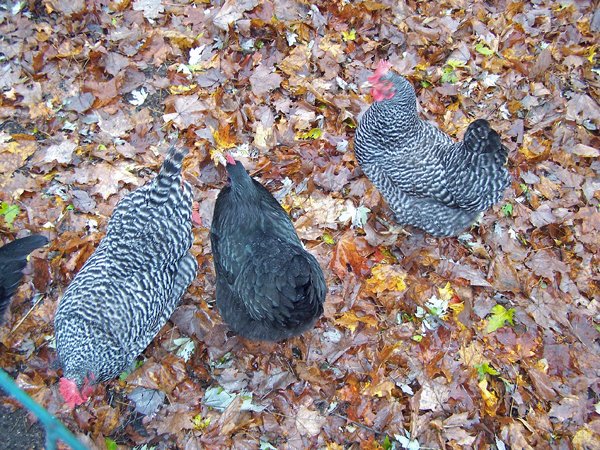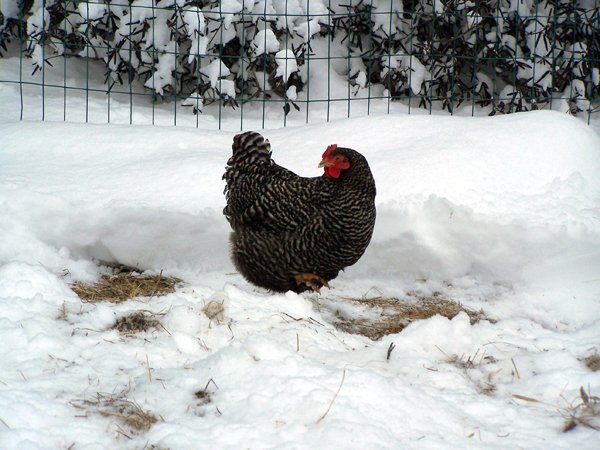
Black Australorps and a Barred Rock
“Black Australorp chickens originated in Australia and were introduced in the United States in the 1920s. Developed from Black Orpingtons imported from England, the Australorp was bred for egg production without sacrificing too much in size and meat quality. Some sensational results were made in the Australian program with one hen setting a laying record of 364 eggs in 365 days. To this day, Black Australorps are still one of the best light brown egg layers of all the heavy breeds.” McMurray Hatchery
Because of the laying ability and the meat aspect, we’ve narrowed our choices for a dual purpose bird to these Australorps, and the Barred Rocks. The Australorps are more for laying than meat. But these birds, at 5½ months, have developed extremely well over where they were at culling time in late August. I could not believe how heavy the Australorps were when we caught them to take off bands and move them. Not all of them were, but most were.

The Barred Rocks are supposed to be the earlier maturing and larger birds, but you can see the Australorp is decidedly bigger, above.

When I did the culling, the Barreds were much more mature and I found better quality than I did with the Australorps. Having said that, I got many fewer good birds from the Barreds, only 7 out of 47 birds, where, with relaxed standards due to immaturity, I got 11 Australorps out of 48 birds, but of lesser quality. But it seems that has all been reversed.

Barreds with floppy combs. One in back probably not laying due to comb condition.
We know that the Barreds were the first to lay, several weeks ahead of when we saw the first Australorp in the boxes. But I am currently getting 13 eggs a day most days, from the 18 birds. And half of the eggs are full size, the rest smalls and small mediums. I even get an extra large off and on.
The leaves are to give them something to mess around in, and to serve as carbon to neutralize the manure. We need at least 15 more bags to fill this pen for the winter. I am still trying to get bags of dry leaves to store for next year.

Check out depth of body on this bird, an un-culled one from our first flock in 2008
I am concerned about the lack of breed standards for the Barred Rocks. I have one with a rose comb and several with the large floppy combs. I avoid breeds with large combs due to our very low winter temps here (-25F) and frostbite. Barred Rocks are supposed to have low small combs, like the one in the snow above.
You can see by looking at the Barreds in these photos they mostly do not have the depth of body of the 2008 bird.
There seems to be no breed standards adhered to for production birds, probably because most chicken owners have no clue such things exist. Using anything that resembles the breed characteristics for breeding is a lot cheaper than keeping the breed standard up. This leads to the hybridization I see in my current flock.
I currently am not buying from the big hatcheries, but from a clearing house for the smaller breeders. Generally I’ve gotten better quality, but that’s not saying much. When it takes 90 birds to barely find 18 for a lying flock each year….
But the laying is going very well, for all the lack of body quality. Culling definitely makes a difference.
Congratulations, your post has been selected to be included in my weekly Sustainability Curation Digest for the Minnow Support Project.
Downvoting a post can decrease pending rewards and make it less visible. Common reasons:
Submit
Thank you!
Downvoting a post can decrease pending rewards and make it less visible. Common reasons:
Submit